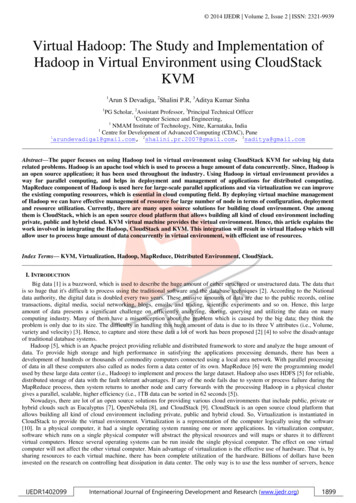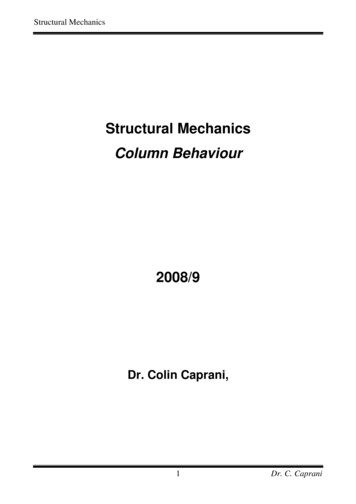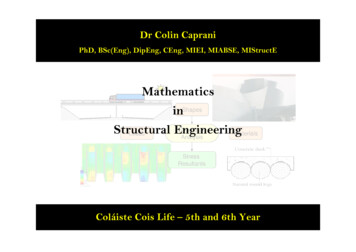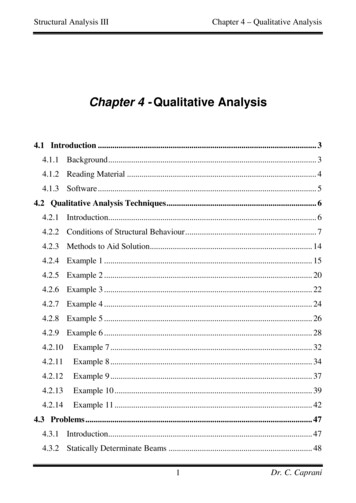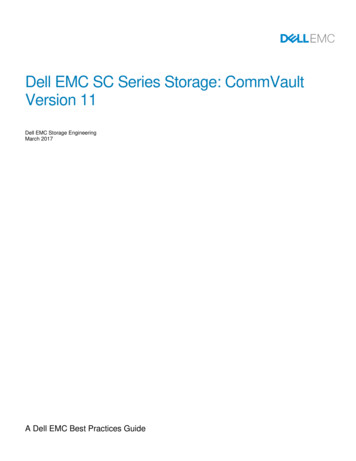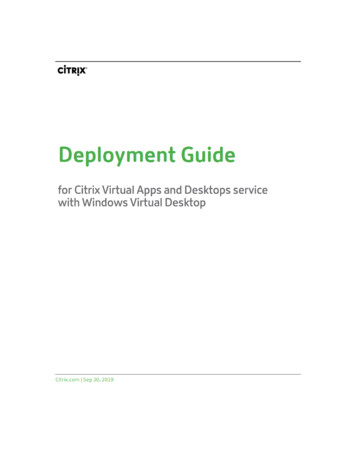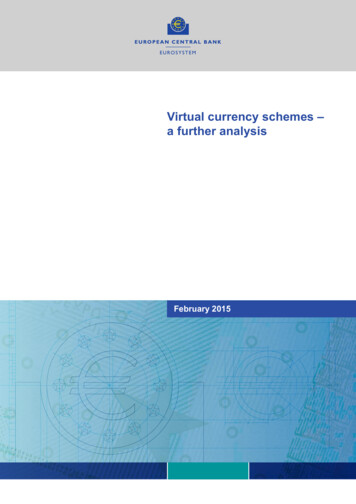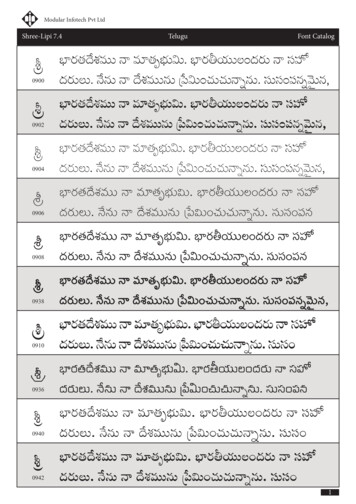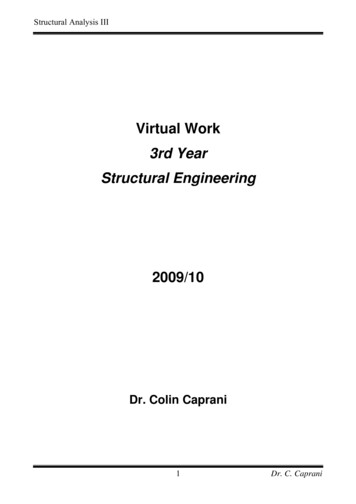
Transcription
Structural Analysis IIIVirtual Work3rd YearStructural Engineering2009/10Dr. Colin Caprani1Dr. C. Caprani
Structural Analysis IIIContents1.2.3.4.5.6.Introduction . 41.1General. 41.2Background. 5The Principle of Virtual Work. 142.1Definition. 142.2Virtual Displacements . 162.3Virtual Forces . 172.4Simple Proof using Virtual Displacements . 182.5Internal and External Virtual Work. 19Application of Virtual Displacements . 213.1Rigid Bodies . 213.2Deformable Bodies . 283.3Problems . 39Application of Virtual Forces. 414.1Basis. 414.2Deflection of Trusses. 424.3Deflection of Beams and Frames . 494.4Integration of Bending Moments. 554.5Problems . 58Virtual Work for Indeterminate Structures. 665.1General Approach. 665.2Using Virtual Work to Find the Multiplier . 685.3Indeterminate Trusses. 715.4Indeterminate Frames . 755.5Continuous Beams . 825.6Problems . 91Virtual Work for Self-Stressed Structures . 942Dr. C. Caprani
Structural Analysis III7.6.1Background. 946.2Trusses . 1006.3Beams . 1066.4Frames. 1096.5Problems . 114Past Exam Questions. 1167.1Summer 1997. 1167.2Summer 1998. 1177.3Summer 1999. 1187.4Summer 2000. 1197.5Summer 2001. 1207.6Summer 2002. 1217.7Summer 2004. 1227.8Summer 2007. 1237.9Semester 2, 2008. 1247.10Semester 2, 2009 . 1257.11Semester 2, 2009 . 1268.References . 1279.Appendix – Volume Integrals. 1283Dr. C. Caprani
Structural Analysis III1. Introduction1.1GeneralVirtual Work is a fundamental theory in the mechanics of bodies. So fundamental infact, that Newton’s 3 equations of equilibrium can be derived from it. Virtual Workprovides a basis upon which vectorial mechanics (i.e. Newton’s laws) can be linkedto the energy methods (i.e. Lagrangian methods) which are the basis for finiteelement analysis and advanced mechanics of materials.Virtual Work allows us to solve determinate and indeterminate structures and tocalculate their deflections. That is, it can achieve everything that all the othermethods together can achieve.Before starting into Virtual Work there are some background concepts and theoriesthat need to be covered.4Dr. C. Caprani
Structural Analysis III1.2BackgroundStrain Energy and Work DoneStrain energy is the amount of energy stored in a structural member due todeformation caused by an external load. For example, consider this simple spring:We can see that as it is loaded by a gradually increasing force, F, it elongates. We cangraph this as:The line OA does not have to be straight, that is, the constitutive law of the spring’smaterial does not have to be linear.5Dr. C. Caprani
Structural Analysis IIIAn increase in the force of a small amount, δ F results in a small increase indeflection, δ y . The work done during this movement (force displacement) is theaverage force during the course of the movement, times the displacement undergone.This is the same as the hatched trapezoidal area above. Thus, the increase in workassociated with this movement is:F (F δ F ) δ y2δ F δ y F δ y 2 F δ yδU (1.1)where we can neglect second-order quantities. As δ y 0 , we get:dU F dyThe total work done when a load is gradually applied from 0 up to a force of F is thesummation of all such small increases in work, i.e.:yU F dy(1.2)0This is the dotted area underneath the load-deflection curve of earlier and representsthe work done during the elongation of the spring. This work (or energy, as they arethe same thing) is stored in the spring and is called strain energy and denoted U.If the load-displacement curve is that of a linearly-elastic material then F ky wherek is the constant of proportionality (or the spring stiffness). In this case, the dottedarea under the load-deflection curve is a triangle.6Dr. C. Caprani
Structural Analysis IIIDraw this:7Dr. C. Caprani
Structural Analysis IIIAs we know that the work done is the area under this curve, then the work done bythe load in moving through the displacement – the External Work Done, We - is givenby:1Fy2We (1.3)We can also calculate the strain energy, or Internal Work Done, WI , by:yU F dy0y ky dy01 ky 22Also, since F ky , we then have:WI U 11( ky ) y Fy22But this is the external work done, We . Hence we have:We WI(1.4)Which we may have expected from the Law of Conservation of Energy. Thus:The external work done by external forces moving through external displacements isequal to the strain energy stored in the material.8Dr. C. Caprani
Structural Analysis IIILaw of Conservation of EnergyFor structural analysis this can be stated as:Consider a structural system that is isolated such it neither gives nor receivesenergy; the total energy of this system remains constant.The isolation of the structure is key: we can consider a structure isolated once wehave identified and accounted for all sources of restraint and loading. For example, toneglect the self-weight of a beam is problematic as the beam receives gravitationalenergy not accounted for, possibly leading to collapse.In the spring and force example, we have accounted for all restraints and loading (forexample we have ignored gravity by having no mass). Thus the total potential energyof the system, Π , is constant both before and after the deformation.In structural analysis the relevant forms of energy are the potential energy of the loadand the strain energy of the material. We usually ignore heat and other energies.Potential Energy of the LoadSince after the deformation the spring has gained strain energy, the load must havelost potential energy, V. Hence, after deformation we have for the total potentialenergy:Π U V1 ky 2 Fy2(1.5)In which the negative sign indicates a loss of potential energy for the load.9Dr. C. Caprani
Structural Analysis IIIPrinciple of Minimum Total Potential EnergyIf we plot the total potential energy against y, equation (1.5), we get a quadratic curvesimilar to:Consider a numerical example, with the following parameters, k 10 kN/m andF 10 kN giving the equilibrium deflection as y F k 1 m . We can plot thefollowing quantities: Internal Strain Energy, or Internal Work:11U WI ky 2 10 y 2 5 y 222 Potential Energy:V Fy 10 y Total Potential Energy:Π U V 5 y 2 10 y External Work:We 11Py 10 y 5 y22and we get the following plots (split into two for clarity):10Dr. C. Caprani
Structural Analysis IIITotal Potential Energy35EnergyExternal Work30Internal 10Deflection, yTotal Potential Energy40Strain EnergyEnergy30Potential -30-40Deflection, yFrom these graphs we can see that because WI increases quadratically with y, whilethe We increases only linearly, WI always catches up with We , and there will alwaysbe a non-zero equilibrium point where We WI .11Dr. C. Caprani
Structural Analysis IIIAdmittedly, these plots are mathematical: the deflection of the spring will not take upany value; it takes that value which achieves equilibrium. At this point we consider asmall variation in the total potential energy of the system. Considering F and k to beconstant, we can only alter y. The effect of this small variation in y is:112Π ( y δ y ) Π ( y ) k ( y δ y ) F ( y δ y ) ky 2 Fy22112 k ( 2 y δ y ) F δ y k (δ y )2212 ( ky F ) δ y k (δ y )2(1.6)Similarly to a first derivate, for Π to be an extreme (either maximum or minimum),the first variation must vanish:δ (1)Π ( ky F ) δ y 0(1.7)ky F 0(1.8)Therefore:Which we recognize to be the Fx 0 . Thus equilibrium occurs when Π is anextreme.Before introducing more complicating maths, an example of the above variation inequilibrium position is the following. Think of a shopkeeper testing an old type ofscales for balance – she slightly lifts one side, and if it returns to position, and nolarge rotations occur, she concludes the scales is in balance. She has imposed a12Dr. C. Caprani
Structural Analysis IIIvariation in displacement, and finds that since no further displacement occurs, the‘structure’ was originally in equilibrium.Examining the second variation (similar to a second derivate):12δ ( 2 )Π k (δ y ) 02(1.9)We can see it is always positive and hence the extreme found was a minimum. This isa particular proof of the general principle that structures take up deformations thatminimize the total potential energy to achieve equilibrium. In short, nature is lazy!To summarize our findings: Every isolated structure has a total potential energy; Equilibrium occurs when structures can minimise this energy; A small variation of the total potential energy vanishes when the structure is inequilibrium.These concepts are brought together in the Principle of Virtual Work.13Dr. C. Caprani
Structural Analysis III2. The Principle of Virtual Work2.1DefinitionBased upon the Principle of Minimum Total Potential Energy, we can see that anysmall variation about equilibrium must do no work. Thus, the Principle of VirtualWork states that:A body is in equilibrium if, and only if, the virtual work of all forces acting onthe body is zero.In this context, the word ‘virtual’ means ‘having the effect of, but not the actual formof, what is specified’. Thus we can imagine ways in which to impose virtual work,without worrying about how it might be achieved in the physical world.Virtual WorkThere are two ways to define virtual work, as follows.1. Principle of Virtual Displacements:Virtual work is the work done by the actual forces acting on the body movingthrough a virtual displacement.This means we solve an equilibrium problem through geometry.2. Principle of Virtual Forces:Virtual work is the work done by a virtual force acting on the body movingthrough the actual displacements.This means we solve a geometry problem through equilibrium.14Dr. C. Caprani
Structural Analysis IIIIllustrate the Principle of Virtual Displacements:Illustrate the Principle of Virtual Forces:15Dr. C. Caprani
Structural Analysis III2.2Virtual DisplacementsA virtual displacement is a displacement that is only imagined to occur. This isexactly what we did when we considered the vanishing of the first variation of Π ; wefound equilibrium. Thus the application of a virtual displacement is a means to findthis first variation of Π .So given any real force, F, acting on a body to which we apply a virtualdisplacement. If the virtual displacement at the location of and in the direction of F isδ y , then the force F does virtual work δ W F δ y .There are requirements on what is permissible as a virtual displacement. Forexample, in the simple proof of the Principle of Virtual Work (to follow) it can beseen that it is assumed that the directions of the forces applied to P remainunchanged. Thus: virtual displacements must be small enough such that the force directions aremaintained.The other very important requirement is that of compatibility: virtual displacements within a body must be geometrically compatible withthe original structure. That is, geometrical constraints (i.e. supports) andmember continuity must be maintained.In summary, virtual displacements are not real, they can be physically impossible butthey must be compatible with the geometry of the original structure and they must besmall enough so that the original geometry is not significantly altered.As the deflections usually encountered in structures do not change the overallgeometry of the structure, this requirement does not cause problems.16Dr. C. Caprani
Structural Analysis III2.3Virtual ForcesSo far we have only considered small virtual displacements and real forces. Thevirtual displacements are arbitrary: they have no relation to the forces in the system,or its actual deformations. Therefore virtual work applies to any set of forces inequilibrium and to any set of compatible displacements and we are not restricted toconsidering only real force systems and virtual displacements. Hence, we can use avirtual force system and real displacements. Obviously, in structural design it is thesereal displacements that are of interest and so virtual forces are used often.A virtual force is a force imagined to be applied and is then moved through the actualdeformations of the body, thus causing virtual work.So if at a particular location of a structure, we have a deflection, y, and impose avirtual force at the same location and in the same direction of δ F we then have thevirtual work δ W y δ F .Virtual forces must form an equilibrium set of their own. For example, if a virtualforce is applied to the end of a spring there will be virtual stresses in the spring aswell as a virtual reaction.17Dr. C. Caprani
Structural Analysis III2.4Simple Proof using Virtual DisplacementsWe can prove the Principle of Virtual Work quite simply, as follows. Consider aparticle P under the influence of a number of forces F1 ,K, Fn which have a resultantforce, FR . Apply a virtual displacement of δ y to P, moving it to P’, as shown:The virtual work done by each of the forces is:δ W F1 δ y1 K Fn δ yn FR δ yRWhere δ y1 is the virtual displacement along the line of action of F1 and so on. Nowif the particle P is in equilibrium, then the forces F1 ,K, Fn have no resultant. That is,there is no net force. Hence we have:δ W 0 δ yR F1 δ y1 K Fn δ yn 0(2.1)Proving that when a particle is in equilibrium the virtual work of all the forces actingon it sum to zero. Conversely, a particle is only in equilibrium if the virtual workdone during a virtual displacement is zero.18Dr. C. Caprani
Structural Analysis III2.5Internal and External Virtual WorkConsider the spring we started with, as shown again below. Firstly it is unloaded.Then a load, F, is applied, causing a deflection y. It is now in its equilibrium positionand we apply a virtual displacement, δ y to the end of the spring, as shown:A free body diagram of the end of the spring is:Thus the virtual work done by the two forces acting on the end of the spring is:δ W F δ y ky δ yIf the spring is to be in equilibrium we must then have:δW 0F δ y ky δ y 0F δ y ky δ yF ky19Dr. C. Caprani
Structural Analysis IIIThat is, the force in the spring must equal the applied force, as we already know.However, if we define the following: External virtual work, δ WE F δ y ; Internal virtual work, δ WI ky δ y ;We then have:δW 0δ WI δ WE 0Thus:δ WE δ WI(2.2)which states that the external virtual work must equal the internal virtual work for astructure to be in equilibrium.It is in this form that the Principle of Virtual Work finds most use.Of significance also in the equating of internal and external virtual work, is that thereare no requirements for the material to have any particular behaviour. That is, virtualwork applies to all bodies, whether linearly-elastic, elastic, elasto-plastic, plastic etc.Thus the principle has more general application than most other methods of analysis.Internal and external virtual work can arise from either virtual displacements orvirtual forces.20Dr. C. Caprani
Structural Analysis III3. Application of Virtual Displacements3.1Rigid BodiesBasisRigid bodies do not deform and so there is no internal virtual work done. Thus:δW 0δ WE δ WI F δ yii(3.1) 0A simple application is to find the reactions of statically determinate structures.However, to do so, we need to make use of the following principle:Principle of Substitution of ConstraintsHaving to keep the constraints in place is a limitation of virtual work. However, wecan substitute the restraining force (i.e. the reaction) in place of the restraint itself.That is, we are turning a geometric constraint into a force constraint. This is thePrinciple of Substitution of Constraints. We can use this principle to calculateunknown reactions:1. Replace the reaction with its appropriate force in the same direction (or sense);2. Impose a virtual displacement on the structure;3. Calculate the reaction, knowing δ W 0 .21Dr. C. Caprani
Structural Analysis IIIReactions of Determinate and Indeterminate StructuresFor statically determinate structures, removing a restraint will always render amechanism (or rigid body) and so the reactions of statically determinate structures areeasily obtained using virtual work. For indeterminate structures, removing a restraintdoes not leave a mechanism and hence the virtual displacements are harder toestablish since the body is not rigid.22Dr. C. Caprani
Structural Analysis IIIExample 1Determine the reactions for the following beam:Following the Principle of Substitution of Constraints, we replace the geometricconstraints (i.e. supports), by their force counterparts (i.e. reactions) to get the freebody-diagram of the whole beam:Next, we impose a virtual displacement on the beam. Note that the displacement iscompletely arbitrary, and the beam remains rigid throughout:23Dr. C. Caprani
Structural Analysis IIIIn the above figure, we have imposed a virtual displacement of δ y A at A and thenimposed a virtual rotation of δθ A about A. The equation of virtual work is:δW 0δ WE δ WI F δ yii 0Hence:VA δ y A P δ yC VB δ yB 0Relating the virtual movements of points B and C to the virtual displacements gives:VA δ y A P (δ y A a δθ A ) VB (δ y A L δθ A ) 0And rearranging gives:(VA VB P )δ y A (VB L Pa ) δθ A 024Dr. C. Caprani
Structural Analysis IIIAnd here is the power of virtual work: since we are free to choose any value we wantfor the virtual displacements (i.e. they are completely arbitrary), we can chooseδθ A 0 and δ y A 0 , which gives the following two equations:(VA VB P ) δ y A 0(VB L Pa )δθ A 0VA VB P 0VB L Pa 0But the first equation is just M about A 0 . Fy 0 whilst the second is the same asThus equilibrium equations occur naturally within the virtualwork framework. Note also that the two choices made for the virtual displacementscorrespond to the following virtual displaced configurations: Draw them25Dr. C. Caprani
Structural Analysis IIIExample 2For the following truss, calculate the reaction VC :Firstly, set up the free-body-diagram of the whole truss:Next we release the constraint corresponding to reaction VC and replace it by theunknown force VC and we apply a virtual displacement to the truss to get:26Dr. C. Caprani
Structural Analysis IIIHence the virtual work done is:δW 0δ WE δ WI 10 δy2 VC δ y 0VC 5 kNNote that the reaction is an external force to the structure, and that no internal virtualwork is done since the members do not undergo virtual deformation. The truss rotatesas a rigid body about the support A.Problem:Find the horizontal reactions of the truss.27Dr. C. Caprani
Structural Analysis III3.2Deformable BodiesBasisFor a virtual displacement we have:δW 0δ WE δ WI F δ y P δ eiiiiIn which, for the external virtual work, Fi represents an externally applied force (ormoment) and δ yi its virtual displacement. And for the internal virtual work, Pirepresents the internal force in member i and δ ei its virtual deformation. Differentstress resultants have different forms of internal work, and we will examine these.Lastly, the summations reflect the fact that all work done must be accounted for.Remember in the above, each the displacements must be compatible and the forcesmust be in equilibrium, summarized as:Set of forces inequilibrium F δ y P δ eiiiiSet of compatibledisplacements28Dr. C. Caprani
Structural Analysis IIIThese displacements are completely arbitrary (i.e. we can choose them to suit ourpurpose) and bear no relation to the forces above. For example, the simple trussshown has a set of forces in equilibrium along with its actual deformed shape. Alsoshown is an arbitrary set of permissible compatible displacements:Loading and dimensionsEquilibrium forces and actual deformationCompatible set of displacements29Dr. C. Caprani
Structural Analysis IIIInternal Virtual Work by Axial ForceMembers subject to axial force may have the following: real force by a virtual displacement:δ WI P δ e virtual force by a real displacement:δ WI e δ PWe have avoided integrals over the length of the member since we will only considerprismatic members.30Dr. C. Caprani
Structural Analysis IIIInternal Virtual Work in BendingThe internal virtual work done in bending is one of: real moment by a virtual curvature:δ WI M δκ virtual moment by a real curvature:δ WI κ δ MThe above expressions are valid at a single position in a beam.When virtual rotations are required along the length of the beam, the easiest way todo this is by applying virtual loads that in turn cause virtual moments and hencevirtual curvatures. We must sum all of the real moments by virtual curvatures alongthe length of the beam, hence we have:LL00δ WI M x δκ x dx κ x δ M x dxL Mx 0δMxEI xdx31Dr. C. Caprani
Structural Analysis IIIInternal Virtual Work in ShearAt a single point in a beam, the shear strain, γ , is given by:γ VGAvwhere V is the applied shear force, G is the shear modulus and Av is the cross-sectionarea effective in shear which is explained below. The internal virtual work done inshear is thus: real shear force by a virtual shear strain:δ WI V δγ V δVGAv virtual shear force by a real shear strain:δ WI γ δ V V δVGAvIn these expressions, the area of cross section effective in shear comes about becausethe shear stress (and hence strain) is not constant over a cross section. The stressV Av is an average stress, equivalent in work terms to the actual uneven stress overthe full cross section, A. We say Av A k where k is the shear factor for the crosssection. Some values of k are 1.2 for rectangular sections, 1.1 for circular sections,and 2.0 for thin-walled circular sections.The above expressions are valid at a single position in a beam and must be integratedalong the length of the member as was done for moments and rotations.32Dr. C. Caprani
Structural Analysis IIIInternal Virtual Work in TorsionAt a single point in a member, the twist, φ , is given by:φ TGJwhere T is the applied torque, G is the shear modulus, J is the polar moment ofinertia. The internal virtual work done in torsion is thus: real torque by a virtual twist:δ WI T δφ T δTGJ virtual torque by a real twist:δ WI δ T φ δ T TGJOnce again, the above expressions are valid at a single position in a beam and mustbe integrated along the length of the member as was done for moments and rotations.Note the similarity between the expressions for the four internal virtual works.33Dr. C. Caprani
Structural Analysis IIIExample 3For the beam of Example 1 (shown again), find the bending moment at C.To solve this, we want to impose a virtual displacement configuration that onlyallows the unknown of interest, i.e. M C , to do any work. Thus choose the following:Since portions AC and CB remain straight (or unbent) no internal virtual work is donein these sections. Thus the only internal work is done at C by the beam movingthrough the rotation at C. Thus:34Dr. C. Caprani
Structural Analysis IIIδW 0δ WE δ WIP δ yC M C δθCBu the rotation at C is made up as:δθC δθCA δθCBδ yC δ yC ab a b δ yC ab But a b L , hence: L P δ yC M C δ yC ab PabMC LWe can verify this from the reactions found previously: M C VB b ( Pa L ) b .35Dr. C. Caprani
Structural Analysis IIISign Convention for RotationsWhen imposing a virtual rotation, if the side that is already in tension due to the realforce system elongates, then positive virtual work is done.Sketch this:36Dr. C. Caprani
Structural Analysis IIIExample 4Calculate the force F1 in the truss shown:To do this, we introduce a virtual displacement along the length of member 1. We dothis so that member 2 does not change length during this virtual displacement and sodoes no virtual work. Note also that compatibility of the truss is maintained. Forexample, the members still meet at the same joint, and the support conditions are met.37Dr. C. Caprani
Structural Analysis IIIThe virtual work done is then:δW 0δ WE δ WIδy 10 2 F1 δ y10 5 2 kN2F1 Note some points on the signs used:1. Negative external work is done because the 10 kN load moves upwards; i.e. thereverse direction to its action.2. We assumed member 1 to be in compression but then applied a virtualelongation to the member thus reducing its internal virtual work. Hencenegative internal work is done.3. We initially assumed F1 to be in compression and we obtained a positiveanswer confirming our assumption.Problem:Investigate the vertical and horizontal equilibrium of the loaded joint by consideringvertical and horizontal virtual displacements separately.38Dr. C. Caprani
Structural Analysis III3.3Problems1. For the truss shown, calculate the vertical reaction at C and the forces in themembers, using virtual work.2. For the truss shown, find the forces in the members, using virtual work:39Dr. C. Caprani
Structural Analysis III3. Using virtual work, calculate the reactions for the beams shown, and thebending moments at salient points.Beam 1Beam 2Beam 340Dr. C. Caprani
Structural Analysis III4. Application of Virtual Forces4.1BasisWhen virtual forces are applied, we have:δW 0δ WE δ WI y δ F e δ PiiiiAnd again note that we have an equilibrium set of forces and a compatible set ofdisplacements:Set of compatibledisplacements y δ F e δ PiiiiSet of forces inequilibriumIn this case the displacements are the real displacements that occur when the structureis in equilibrium and the virtual forces are any set of arbitrary forces that are inequilibrium.41Dr. C. Caprani
Structural Analysis III4.2Deflection of TrussesIllustrative ExampleFor the truss shown below, we have the actual displacements shown with twopossible sets of virtual forces.Actual
1. Principle of Virtual Displacements: Virtual work is the work done by the actual forces acting on the body moving through a virtual displacement. This means we solve an equilibrium problem through geometry. 2. Principle of Virtual Forces: Virtual work is the work done by a virtual force acting on the body moving through the actual displacements.


